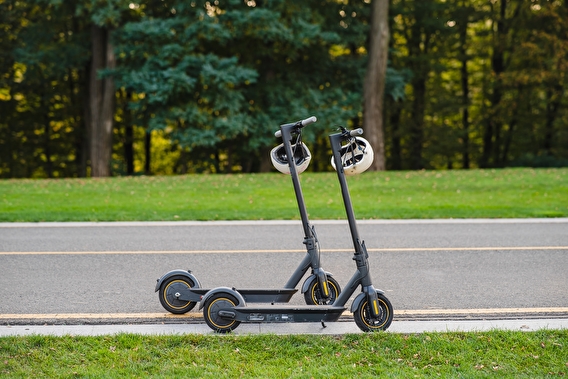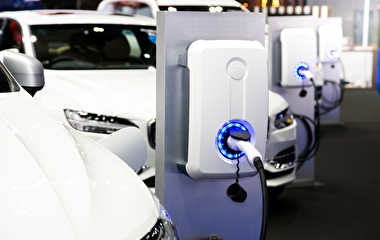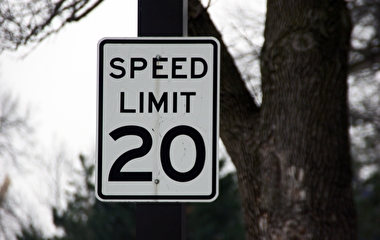
Zippy electric scooters—often called e-scooters—have quickly become a common sight on sidewalks, bike paths, and roads in most US urban areas. Americans took 38.5 million e-scooter rides in 2018 and 88.5 million rides in 2019—a 130 percent increase in a single year. However, the rapid rise of the e-scooter has come at a cost, and e-scooter injuries and crashes have become a serious public health concern.
“The research that’s been done on e-scooter crashes has looked at hospitalizations, but we know much less about crash and injury risks among general e-scooter users who don’t end up in the hospital,” says Nichole Morris, director of the U of M’s HumanFIRST Laboratory. “Also, the link between riders’ behaviors—in particular, their infrastructure selection—and their risk for crashes and injuries isn’t clear.”
To help answer these questions, U researchers set out to identify the characteristics and risk factors for e-scooter crashes and injuries. They focused on the association between riders’ use of infrastructure (such as sidewalks, roads, and bike paths) and e-scooter crashes and injuries. Additional factors such as demographics and helmet use were also examined.
“We knew this would be powerful knowledge,” says Disi Tian, a postdoc at the HumanFIRST Lab and former doctoral student in the U’s Midwest Center for Occupational Health and Safety (MCOHS) in the School of Public Health. “Our goal was to identify factors that could be modified to mitigate e-scooter-related crash and injury risks and promote safer riding.”
Others on the research team were Curtis Craig (research associate) and Kelsey Sievert (graduate research assistant) from HumanFIRST and Andrew Ryan (senior research fellow) from MCOHS.
Researchers gathered data in 2021 with a survey of e-scooter riders, generating 210 responses from eligible participants. “More than 25 percent reported having been involved in an e-scooter-related crash, and about 15 percent reported having experienced an injury crash while riding e-scooters,” Tian says.
Next, they analyzed the data to determine the risk ratios of riders’ involvement in an e-scooter-related crash (any crash vs. no crash) and injury crash (injury vs. non-injury crash).
One important finding was the gender differences in crash and injury risk. Researchers found that males had a greater risk of being involved in an e-scooter crash, likely because they were generally more frequent riders, had fewer perceived concerns about safety, and were more prone to risk-taking behaviors while riding. However, females had a 1.5 times higher risk of being involved in an e-scooter-related injury crash than males.
“This may suggest a need to examine potential e-scooter design issues that may not adapt well to female riders, such as handlebar height, center of gravity, and required upper body strength,” Morris says.
Other potential reasons—such as reporting bias, lack of experience (e.g., more injuries resulting from novice use), or female riders sometimes being less adept at riding an e-scooter—may also help explain the gender difference in the e-scooter injury risk in this study.
“The type of infrastructure used by e-scooter riders was also a significant factor in crash involvement,” Tian says. Riding more frequently on bike lanes provided protection and reduced e-scooter-related injuries. In contrast, riding on sidewalks more frequently was associated with nearly double the risk of e-scooter-related injury crashes.
Survey results also indicated that riders on sidewalks had significant concerns about running into pedestrians. The researchers are analyzing this data and will publish findings in future papers.
According to the researchers, their work could help inform public policy associated with e-scooters and help establish proactive, informed legislation rather than reactive, trial-and-error approaches.
“Policymakers should prioritize efforts to establish suitable road structures—in particular, bike lanes—for improved e-scooter riding safety,” Morris says. “Future legislation could enhance public education, require additional training for first-time riders, and develop clear sanctions for e-scooter traffic violations such as riding on sidewalks.”
This project was part of a larger study funded by the National Science Foundation (CPS-Cyber-Physical Systems, award number CMMI-2038403). Morris is a co-investigator of the study; the principal investigator is Professor Rajesh Rajamani of the Department of Mechanical Engineering.
Findings are published in a paper titled "Characteristics and Risk Factors for Electric Scooter-Related Crashes and Injury Crashes among Scooter Riders: A Two-Phase Survey Study,” in the International Journal of Environmental Research and Public Health, August 2022, vol. 19, issue 16.
Writer: Megan Tsai


